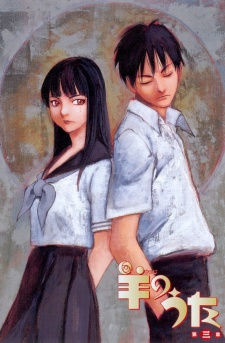
Just from the visual style it surprised me somewhat that Hitsuji no Uta was a manga adaptation. Despite being a story with little or no romance, I felt the pervasive sense that it was ported straight from a visual novel, albeit an older one with fewer branching choices. That sense is probably based on nothing but how the background and characters were stratified, appearing as two flat layers that didn't interact with one another, backgrounds recurring between different shots while character designs were stoic and only reflecting one emotion at a time. It's the sort of setup one would expect when each character has a handful of models swapped in and out based on the dialogue, extremely flat and coarse as compared with the rich yet equally flat background designs.
Such was the sense I got, but since I was wrong I won't persist. Hitsuji no Uta at a glance is simple: a brother in an adopted family finally reunites with his sister while walking past an old house bearing his birth name, and learns the dark secrets behind his family line. Kazuna's average day as an average high school student, going to the art club just to see his dedicated underclassman Yaegashi, is disturbed by a spasm in reaction to her blood. Her deep red painting set the tone nicely for Kazuna's breakdown, even if the change of pace and rapid cycling of static images was a bit of a weird way to go about the scene. Walking home he passes his old house with the name Takashiro on the nameplate, and inside an older girl named Chizuna tells him about the latent vampiric illness of their bloodline, which killed their starving mother and drove their father to suicide. On his next visit her doctor Minase interrupts them, and it becomes clear that the solitary Chizuna is going the way of their mother.
While the story settles squarely on their struggles against the curse of the thirst for blood, the moral dilemma of sucking blood is all but wrapped up by the second episode, when Kazuna decides to seclude himself from the outside world with Chizuna. The decision is mostly told through his failing friendship with Yaegashi, who would rather sacrifice her blood than lose him even after she is thoroughly rejected by Kazuna. Another relationship frayed is Kazuna's adopted parents, with whom he never fought once. Kazuna cuts all his ties to the world, save for his one blood tie in Chizuna, and goes to find a way for them to suppress each others' carnal urges. If that sounds incestuous, they only dodge that bullet by a hair.
From that point on it's a slow burn of isolation and their weaknesses. Chizuna, reliant on a potent medicine that's killing her only slightly less than it's saving her, is the lynchpin of Kazuna's life (a brief aside: Chizuna literally means “a thousand grains of sand”, which considering her impending death is fairly ironic compared against Kazuna, meaning “single grain”). He holds onto a capsule of lethal poison just waiting for her to pass so he can join her. I couldn't tell how much I believed his personality reversal over the course of the very few days in which Hitsuji no Uta took place, but Chizuna's character was consistent and transmitted well by Hayashibara Megumi's performance. A side plot explores her doctor's obsession with keeping her alive, a nifty but creepy parallel to Kazuna's obsession, but ultimately the narrative succeeds in letting the siblings shut out the world around them in waiting for their lives, and with them the Takashiro bloodline, to fade out.
As a reminder, all of this is being told through fairly static character models placed against static background images. While it wasn't to the point of being a picture drama—not even close—I wonder what prompted the experienced director Sugii Gisaburou to choose this style. For as controlled as the voice work was, they spoke out of bland untexturized character models, often times without any mouth movement. The establishing shots for the environments were rich in lighting, texture, and detail, but again all those elements often felt flattened onto a single plane, even the set pieces that should be closer to the camera than the characters.
It's hard to pull other details from my mind, such as dialogue and music; they basically all flew at the level of “getting the job done,” though not nearly as much as the art. I found that the story walked the line between vampire tales and “main character syndrome” drama, two of my least favorite genres, quite cleanly, but all the thoughtful framing and lighting work didn't pull me in past the slapdash foreground blocking its way. Years of playing random visual novels eventually made me realize when a work was high-profile and when it was dashed off by the company during a lull, and despite Sugii's directing and great voicework by Hayashibara and Seki Tomokazu, it does really feel like a project worked out during their lunch breaks, even with all the thought and sensibility at its core.